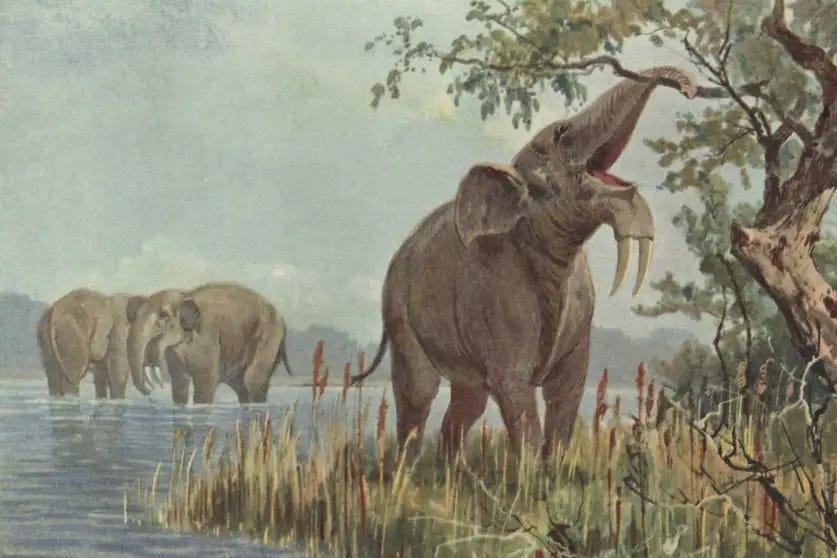How Early Hunters Drove Elephant Relatives to Extinction
Manage episode 431661787 series 3444207
The extinction of numerous elephant-like species over the past 2 million years has been significantly influenced by human hunting activities, according to a recent AI-assisted analysis1 of fossil records. The study highlights that the extinction rate of these animals increased five-fold with the evolution of early humans around 1.8 million years ago and continued to rise with the appearance of modern humans. Today, only three elephant species remain from this once diverse group.
The Rise and Fall of Proboscideans
Proboscideans, named after the Latin word for trunk, were thriving and diversifying in the millions of years before human arrival. According to Torsten Hauffe from the University of Fribourg,
"If early humans had not appeared, the number of species would probably still be increasing."
The evolutionary development of tougher teeth for eating grass contributed to their diversification. Around 1.8 million years ago, there were about 30 species of proboscideans. However, the territories of these animals began to overlap with those of early humans, marking the beginning of a dramatic decline in their numbers.
The Impact of Early Humans
The study's findings indicate a strong correlation between human presence and proboscidean extinction rates. For instance, Deinotherium bozasi, a species with unique downwards and backwards-pointing tusks from its lower jaw, went extinct about a million years ago. By the time modern humans began spreading approximately 130,000 years ago, only 15 species of proboscideans remained. Most of these species eventually went extinct, leaving only the Asian elephant, the African bush elephant, and the African forest elephant.

AI-Assisted Analysis and Insights
To uncover the reasons behind these extinctions, Hauffe and his team developed a statistical model that estimates changes in extinction and speciation rates over time based on fossil records. Unlike previous models that focused on single factors such as climate, this AI-enhanced model considers multiple factors simultaneously. Hauffe explains,
"We combined everything in a single analysis.”
The study concludes that human overlap is the most significant factor associated with proboscidean extinctions, followed by geographic distribution and the morphology of teeth and tusks. For example, species confined to islands, like the Sicilian dwarf elephant (Palaeoloxodon falconeri), faced higher extinction risks. Climate change, previously thought to be a primary cause, ranks fourth among the contributing factors. These findings support the overkill hypothesis, which posits that human hunting played a crucial role in these extinctions.
Broader Implications and Ongoing Debates
The implications of this study extend beyond proboscideans. A computer modeling study of woolly rhinos earlier this year also supported the notion that even low levels of hunting could drive slow-breeding animals to extinction. Steven Zhang from the University of Helsinki, who contributed fossil data for the proboscidean study, notes,
"What is clear is that early people didn’t suddenly wipe out proboscideans."
The debate over the primary causes of these extinctions continues. A 2021 analysis using a different method suggested that while human impact is plausible, climate change was a fundamental driving force. Zhang emphasizes that some of the most iconic extinct elephant species, such as the gigantic Palaeoloxodon of Eurasia and the woolly mammoth, emerged within this time frame and coexisted with early humans.
Human-Proboscidean Interactions: A Complex History
The relationship between early humans and proboscideans is complex. Sites where early humans butchered mammoths or Palaeoloxodon species date back more than a million years. Despite the increasing cognitive and technological sophistication of prehistoric humans, these lineages survived into the last 25,000 years. The continued coexistence and eventual extinction of proboscideans reflect the intricate interplay of environmental changes, human activities, and evolutionary processes.
Conclusion
This research underscores the profound impact of human evolution on the extinction of elephant-like species and highlights the importance of considering multiple factors in understanding historical biodiversity changes. The ongoing exploration of human-proboscidean interactions offers valuable insights into the broader narrative of human evolution and environmental adaptation.
Hauffe, T., Cantalapiedra, J. L., & Silvestro, D. (2024). Trait-mediated speciation and human-driven extinctions in proboscideans revealed by unsupervised Bayesian neural networks. Science Advances, 10(30). https://doi.org/10.1126/sciadv.adl2643
8 episodes




